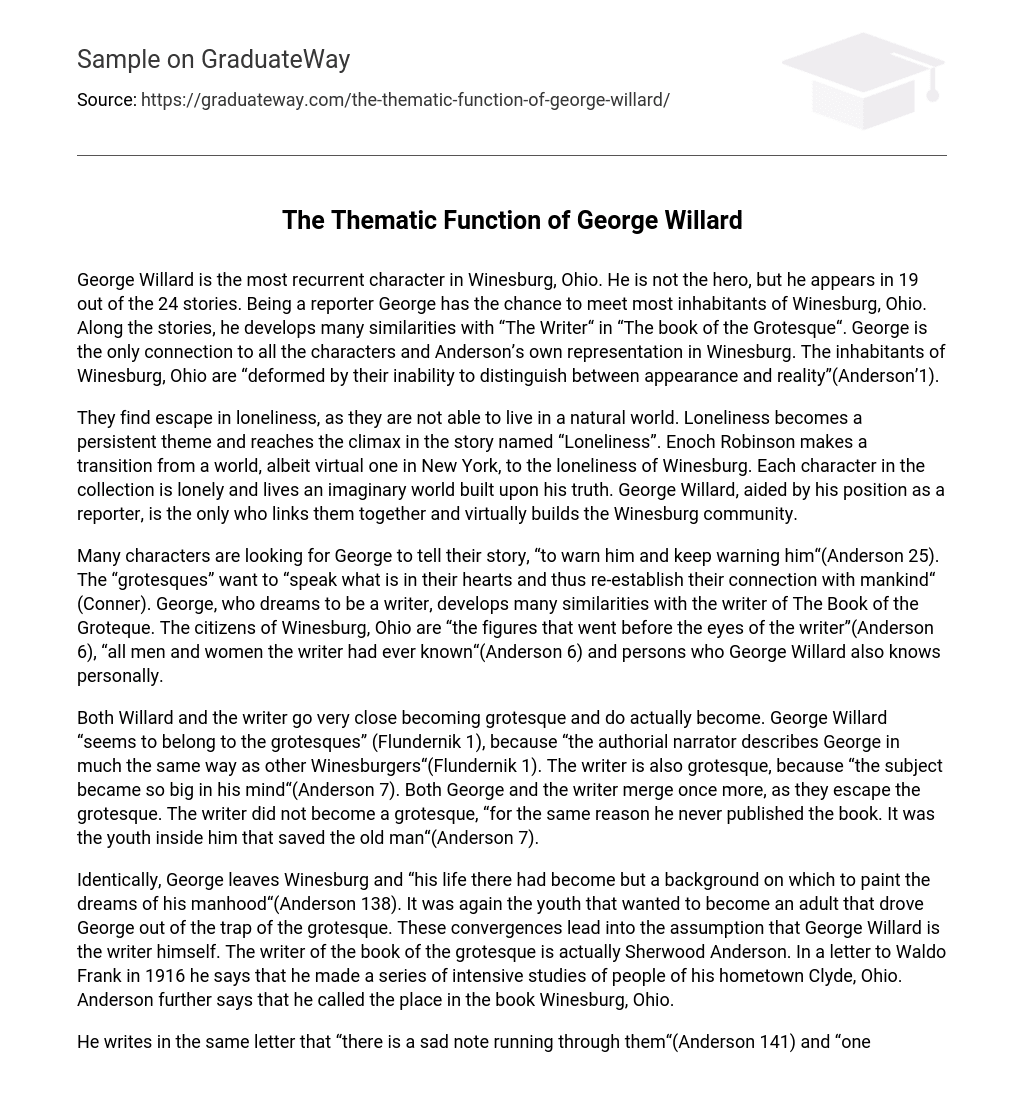George Willard is the most recurrent character in Winesburg, Ohio. He is not the hero, but he appears in 19 out of the 24 stories. Being a reporter George has the chance to meet most inhabitants of Winesburg, Ohio. Along the stories, he develops many similarities with “The Writer“ in “The book of the Grotesque“. George is the only connection to all the characters and Anderson’s own representation in Winesburg. The inhabitants of Winesburg, Ohio are “deformed by their inability to distinguish between appearance and reality”(Anderson’1).
They find escape in loneliness, as they are not able to live in a natural world. Loneliness becomes a persistent theme and reaches the climax in the story named “Loneliness”. Enoch Robinson makes a transition from a world, albeit virtual one in New York, to the loneliness of Winesburg. Each character in the collection is lonely and lives an imaginary world built upon his truth. George Willard, aided by his position as a reporter, is the only who links them together and virtually builds the Winesburg community.
Many characters are looking for George to tell their story, “to warn him and keep warning him“(Anderson 25). The “grotesques” want to “speak what is in their hearts and thus re-establish their connection with mankind“ (Conner). George, who dreams to be a writer, develops many similarities with the writer of The Book of the Groteque. The citizens of Winesburg, Ohio are “the figures that went before the eyes of the writer”(Anderson 6), “all men and women the writer had ever known“(Anderson 6) and persons who George Willard also knows personally.
Both Willard and the writer go very close becoming grotesque and do actually become. George Willard “seems to belong to the grotesques” (Flundernik 1), because “the authorial narrator describes George in much the same way as other Winesburgers“(Flundernik 1). The writer is also grotesque, because “the subject became so big in his mind“(Anderson 7). Both George and the writer merge once more, as they escape the grotesque. The writer did not become a grotesque, “for the same reason he never published the book. It was the youth inside him that saved the old man“(Anderson 7).
Identically, George leaves Winesburg and “his life there had become but a background on which to paint the dreams of his manhood“(Anderson 138). It was again the youth that wanted to become an adult that drove George out of the trap of the grotesque. These convergences lead into the assumption that George Willard is the writer himself. The writer of the book of the grotesque is actually Sherwood Anderson. In a letter to Waldo Frank in 1916 he says that he made a series of intensive studies of people of his hometown Clyde, Ohio. Anderson further says that he called the place in the book Winesburg, Ohio.
He writes in the same letter that “there is a sad note running through them“(Anderson 141) and “one or two of them get pretty closely down to ugly things of life“(Anderson 141). These characteristics are what the old writer calls grotesque. As both, Winesburg, Ohio and The Book of the Grotesque talk about grotesque people they are interchangeable names for the same book. These facts guide into the conclusion that the old writer is Sherwood Anderson himself and he is represented in the collection by George Willard. George appears as the main character of the very last story, but he is the most frequent one in Winesburg, Ohio.
George, working as a reporter, knows all the inhabitants of Winesburg. They look out for him as a way to leave the loneliness behind and re-establish their connection with mankind. The Winesburgers are persons the “old writer“ met through his life. George and the writer are the only characters to know the entire Winesburg community. They also share the characteristics of becoming grotesque and running away from it. “The old writer“ is actually Sherwood Anderson. The inhabitants of Winesburg are people of Anderson’s hometown Clyde, Ohio.
As George Willard shares many characteristics with “the old writer“ who is indeed Anderson himself, George is Anderson’s representation in the book and focal point of connection with the lonely Winesburg community.
Bibliography
Anderson, Sherwood. Winesburg, Ohio New York: W. W Norton and Company,1996. Anderson D. David. Sherwood Anderson’s Idea of the Grotesque OHIOANA: of Ohio and Ohioans, 1963 Conner, Mark C. “Fathers and Sons: Winesburg, Ohio and the Revision of Modernism. ” Studies in American Fiction Vol. 29, 2001 Flundernik, Monika. “Winesburg, Ohio: The apprenticeship of George Willard” Amerikastudien 32 S. 431-452, 1987





